

In May 2021, a team led by Mohammad Azizur Rahman, Associate Professor of the Department of Biochemistry and Molecular Biology, Jahangirnagar University, Bangladesh, and the Mushroom Development Institute, Department of Agricultural Extension, Ministry of Agriculture, Bangladesh jointly published a retrospective paper in the International Journal of Medicinal Mushrooms to guide people under the COVID-19 pandemic to make good use of “known knowledge” and “existing resources” to seek self-protection in the long wait for salvation with new drugs.
Based on the scientifically verified results, through the evaluation of practical considerations such as edible safety and accessibility of edible and medicinal mushrooms and the analysis of their role in antivirus, immune regulation, reduction of inflammation caused by ACE/ACE2 imbalance and improvement of common chronic diseases such as cardiovascular disease, diabetes, hyperlipidemia, and hypertension in patients with coronavirus disease 2019 (COVID-19), the paper expounded the reasons why people should “eat mushrooms to prevent epidemics”.
The paper pointed out several times in the article that Ganoderma lucidum is undoubtedly the most suitable choice for the prevention and treatment of novel coronavirus pneumonia among many edible and medicinal fungi because of its rich and diverse active ingredients.
That Ganoderma lucidum inhibits virus replication, regulates excessive and insufficient immune responses (anti-inflammation and resistance enhancement) is not strange to everyone and has been discussed in many articles:
It is easy to understand that Ganoderma lucidum, which is already good at protecting the heart and liver, protecting the lungs and strengthening the kidneys, regulating the three highs, and anti-aging, can improve the odds of patients with chronic diseases and middle-aged and elderly people in the fight against novel coronavirus pneumonia.
But what is the ACE/ACE2 imbalance? What does it have to do with inflammation? How does Ganoderma lucidum intervene in coordination?
ACE/ACE2 imbalance can aggravate inflammation.
ACE2 (angiotensin converting enzyme 2) is not only the receptor for SARS-CoV-2 to invade cells but also has the catalytic activity of enzymes. Its main role is to counterbalance another ACE (angiotensin converting enzyme) that looks very similar but has completely different functions.
When the kidney detects a decrease in blood volume or blood pressure (such as bleeding or dehydration), it secretes renin into the blood. The enzyme secreted by the liver is converted into an inactive “angiotensin I”. When angiotensin I flow with the blood through the lungs for gas exchange, the ACE in the alveolar capillaries converts it into a truly active “angiotensin II” that acts throughout the body.
In other words, ACE plays a key role in the “renin-angiotensin system” that maintains constant blood pressure and blood volume (while maintaining constant body fluids and electrolytes).
It’s just that you can’t keep the blood vessels in a tight, high-pressure state like this! That can increase the workload of the heart to push the blood and the kidneys to filter the blood. What’s more, angiotensin II not only promotes vasoconstriction but also promotes inflammation, oxidation and fibrosis. Its continuous damage to the body will not be limited to high blood pressure!
Therefore, in order to have a balance, the body cleverly configures ACE2 on the surface of vascular endothelial cells, alveolar, heart, kidney, small intestine, bile duct, testis and other tissue cells, so that it can convert angiotensin II into ang (1-7) that widens blood vessels, lowers blood pressure and is capable of anti-inflammation, anti-oxidation and anti-fibrosis.

In other words, ACE2 is a lever used in the body to balance the production of excessive angiotensin II by ACE. However, ACE2 happens to be a sally port for the novel coronavirus to invade cells.
When ACE2 is combined with the spike protein of the novel coronavirus, it will be dragged into the cell or shed into the blood due to structural damage, so that the ACE2 on the surface of the cell is greatly reduced and is unable to counterbalance the angiotensin II activated by ACE.
As a result, the inflammatory response induced by the virus is intertwined with the pro-inflammatory effect of angiotensin II. The increasingly intense inflammatory response will inhibit the synthesis of ACE2 by cells, making the chain damage caused by the imbalance of ACE/ACE2 more serious. It will also make the oxidative damage and fibrosis damage of tissues and organs more serious.
Clinical studies have observed that the angiotensin Ⅱ of patients with coronavirus disease 2019 (COVID-19) is significantly increased, and it is positively correlated with the amount of virus, the degree of lung injury, the occurrence of acute pneumonia and acute respiratory distress syndrome. Studies have also pointed out that the intensified inflammatory response, increased blood pressure, and increased blood volume caused by the imbalance of ACE/ACE2 are important reasons that increase the burden on the heart and kidneys of patients with novel coronavirus pneumonia and cause myocardial and kidney disease.
Inhibition of ACE can improve ACE/ACE2 imbalance
Many ingredients contained in Ganoderma lucidum can inhibit ACE
Since ACE inhibitors commonly used in the treatment of hypertension can inhibit the activity of ACE, reduce the production of angiotensin II and alleviate the chain damage caused by the imbalance of ACE/ACE2, they are considered to be helpful for the treatment of novel coronavirus pneumonia.
Bangladeshi scholars used this argument as one of the reasons why edible and medicinal fungi are suitable for the prevention and treatment of COVID-19.
Because according to past research, many edible and medicinal fungi have active ingredients that inhibit ACE, among which Ganoderma lucidum has the most abundant active ingredients.
Both the polypeptides contained in the water extract of Ganoderma lucidum fruiting bodies and the triterpenoids (such as ganoderic acids, ganoderenic acids and ganederols) existing in the methanol or ethanol extract of Ganoderma lucidum fruiting bodies can inhibit ACE activity (Table 1) and their inhibitory effect is relatively excellent among many edible and medicinal fungi (Table 2).
More importantly, as early as the 1970s, clinical studies in China and Japan have confirmed that Ganoderma lucidum can effectively lower high blood pressure, indicating that Ganoderma lucidum‘s inhibition of ACE is not only a “possible activity” but also can work through the gastrointestinal tract.
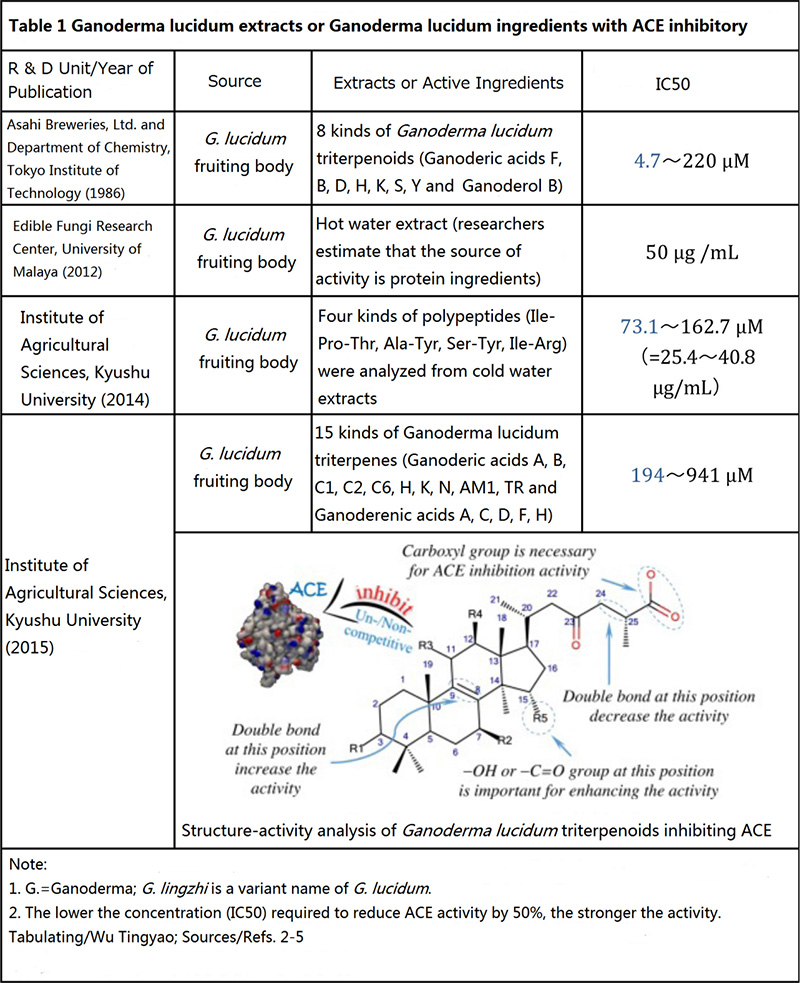
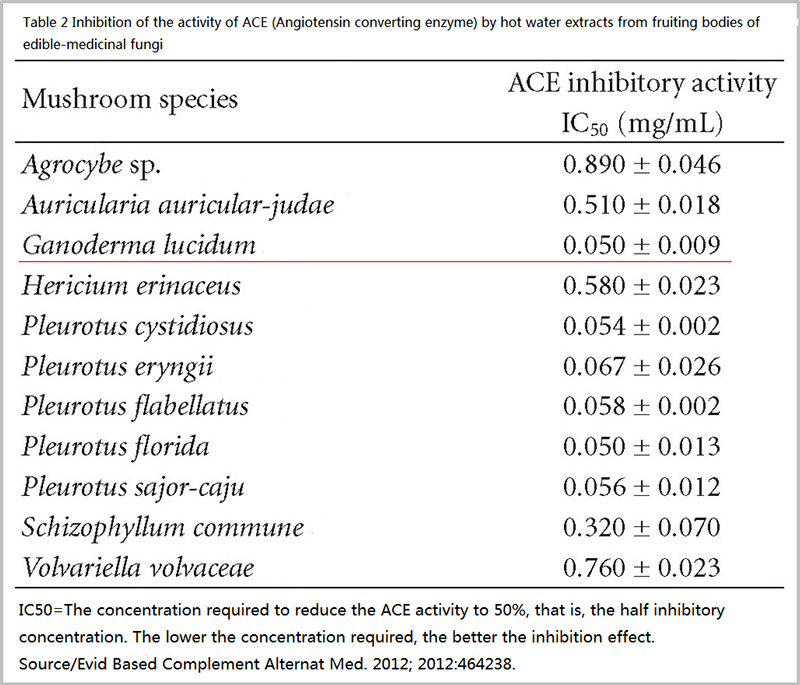
Clinical application of ACE inhibitors
Considerations for improving ACE/ACE2 imbalance
Whether to use ACE inhibitors to treat novel coronavirus pneumonia has once made the medical community hesitate.
Because inhibiting ACE will indirectly increase the expression of ACE2. Although it is a good thing to fight inflammation, oxidation and fibrosis, ACE2 is the receptor of the novel coronavirus. So whether inhibition of ACE protects tissues or exacerbates infection was still worrying.
Nowadays, there have been multiple clinical studies (see References 6-9 for details) that ACE inhibitors do not worsen the condition of patients with coronavirus pneumonia. Therefore, many heart or hypertension associations in Europe and the United States have clearly recommended patients to continue the use of the ACE inhibitor if no adverse clinical conditions occur.
As for COVID-19 patients who did not use ACE inhibitors, especially those without hypertension, heart disease or diabetes indications, whether additional ACE inhibitors should be given is currently inconclusive mainly because although clinical studies have observed the benefits of using ACE inhibitors (such as higher survival rate), the effect does not seem to be obvious enough to become a medical guideline recommendation.
The role of Ganoderma lucidum is more than inhibiting ACE
It is not surprising that ACE inhibitors may not be able to exert significant effects during the clinical observation period (usually 1 day to 1 month). The uncontrolled inflammation caused by the fight between the virus and the immune system is the root cause of the deterioration of the novel coronavirus pneumonia. Since the culprit has not been eliminated, it is of course difficult to turn things around in the first time by suppressing ACE to deal with the accomplices.
The problem is that the ACE/ACE2 imbalance is likely to be the last straw to crush the camel, and it is more likely to become a stumbling block for future recovery. Therefore, if you think from the perspective of pursuing good fortune and avoiding disaster, the good use of ACE inhibitors will help the recovery of patients with novel coronavirus pneumonia.
However, compared with the side effects that may be caused by synthetic ACE inhibitors, such as dry cough, allotriogeusti and elevated blood potassium, the Bangladeshi scholar who wrote this paper believed that the ACE-inhibiting components in naturally-occurring edible and medicinal fungi will not cause physical burden. In particular, Ganoderma lucidum, which has many ACE-inhibiting components and a relatively excellent inhibitory effect, is more worth looking forward to.
What’s more, many Ganoderma lucidum extracts or Ganoderma lucidum ingredients that inhibit ACE can also inhibit virus replication, regulate inflammation (avoid cytokine storm), enhance immunity, protect cardiovascular systems, regulate blood sugar, regulate blood pressure, regulate blood lipids, reduce liver injury, reduce kidney injury, reduce lung injury, protect the respiratory tract, protect the intestinal tract. Synthetic ACE inhibitory ingredients or other ACE inhibitory ingredients derived from edible and medicinal fungi cannot be compared with Ganoderma lucidum in this regard.
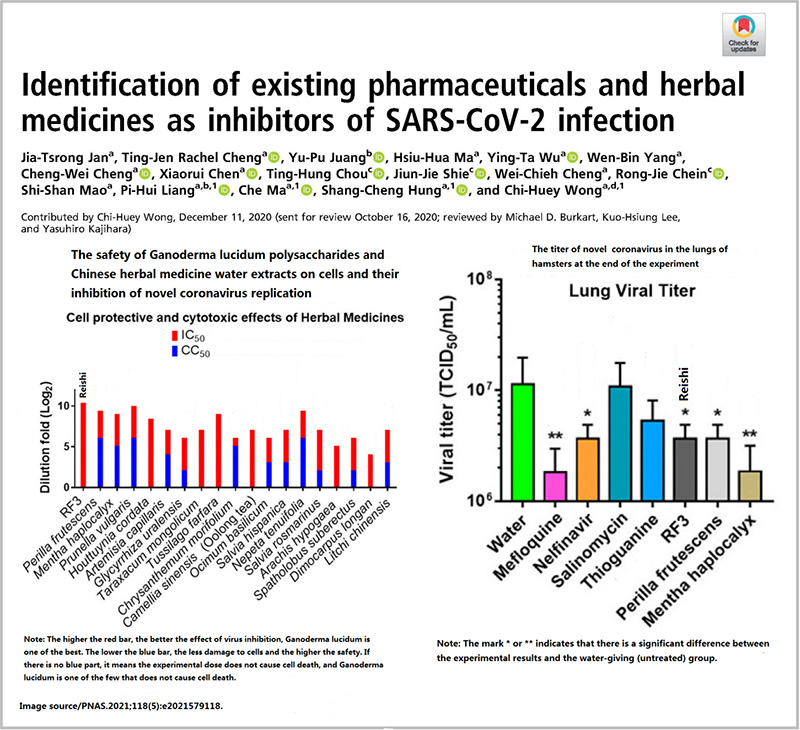
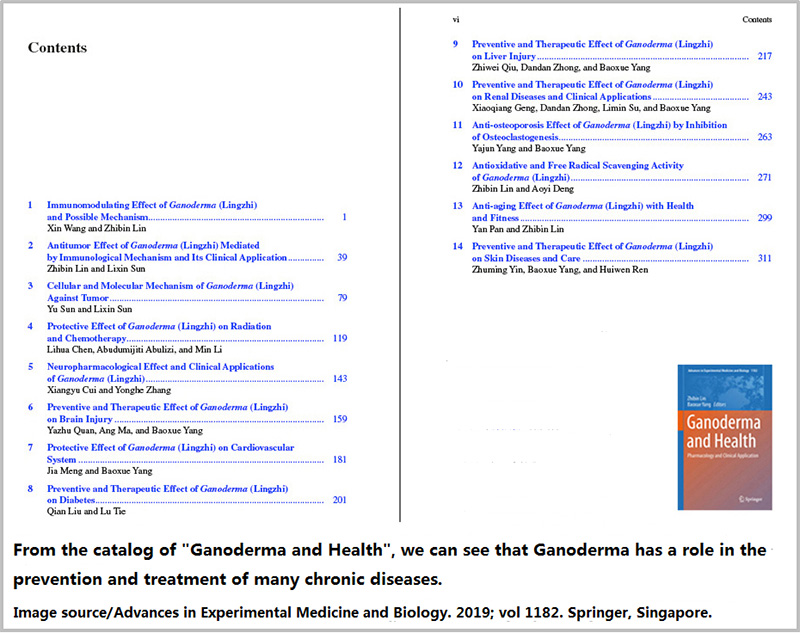
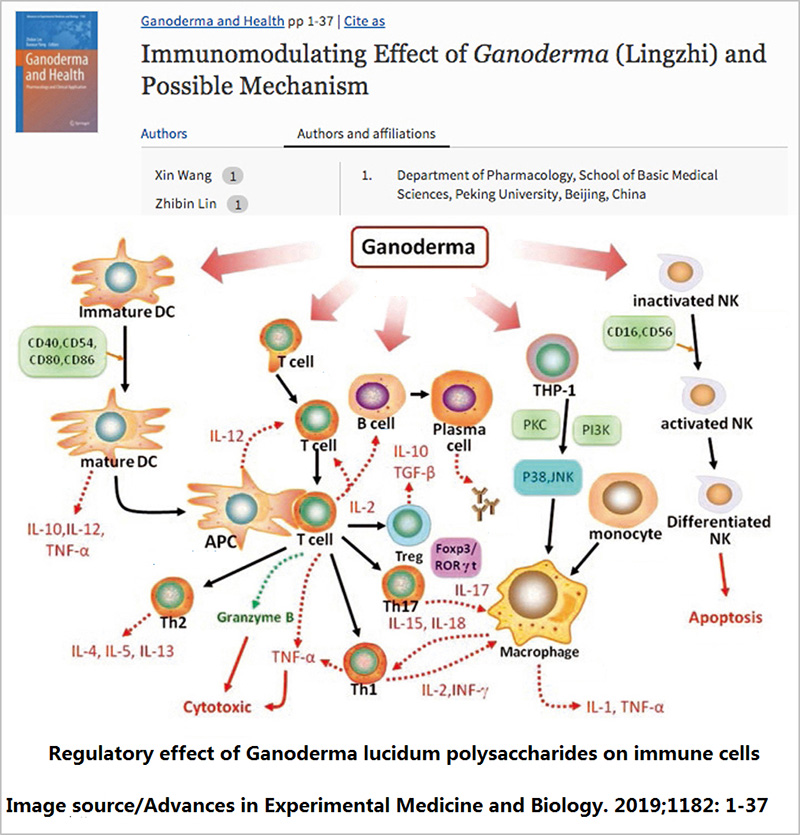
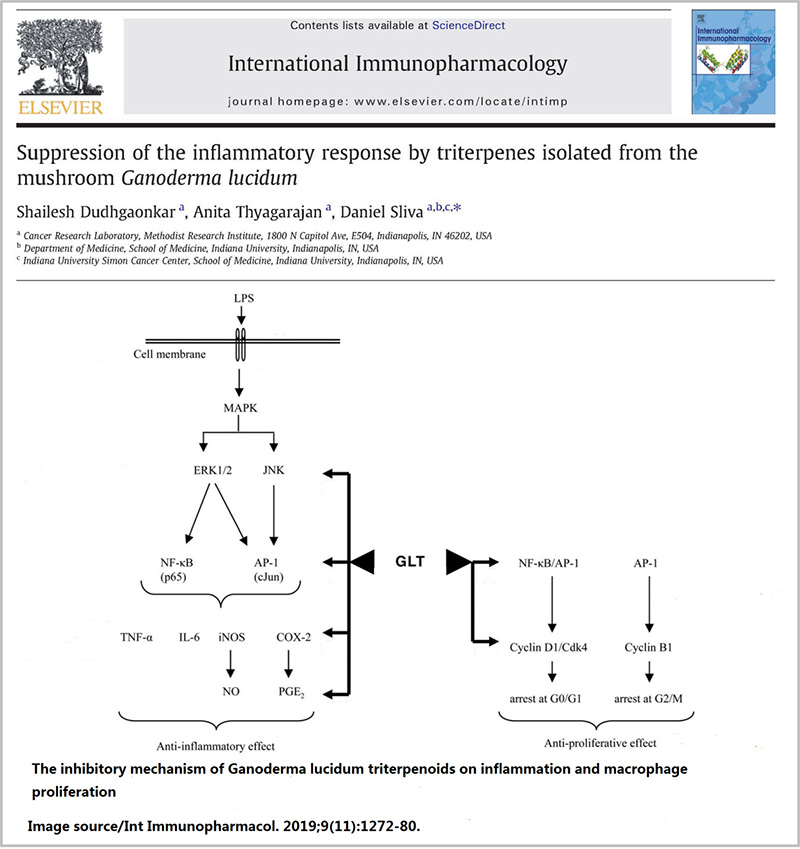
Reducing the risk of severe illness and death is just alleviating the crisis.
From the moment the novel coronavirus chooses ACE2 as the invasion receptor, it is destined to be different from other viruses in lethality and complexity.
Because too many tissue cells in the human body have ACE2. The novel coronavirus can damage the alveoli and cause hypoxia throughout the body, follow the blood to find a suitable base in the body, attract immune cells everywhere to attack, destroy the ACE/ACE2 balance everywhere, intensify inflammation, oxidation and fibrosis, increase blood pressure and blood volume, increase the burden on the heart and kidneys, make body fluids and electrolytes imbalance which affects cell operations, and trigger more domino effects.
Therefore, infection with novel coronavirus pneumonia is by no means “getting a more serious cold” which “only affects the lungs”. It will have long-term sequelae to the body’s tissues, organs and physiological functions.
Although the good news about the development of various new drugs for the prevention and treatment of COVID-19 is very exciting, some imperfect facts are close at hand:
Vaccination (inducing antibodies) does not guarantee that there will be no infection;
Antiviral drugs (inhibition of virus replication) cannot guarantee the cure of the disease;
Steroid anti-inflammation (immune suppression) is a double-edged sword;
Complications may not be avoided even if there is no severe illness;
The change of virus screening from positive to negative does not necessarily mean a successful fight against the epidemic;
Walking out of the hospital alive does not mean that you will be able to fully recover in the future.
When the coronavirus drugs and vaccines have helped us grasp the “general direction” of reducing the risk of severe illness, reducing the probability of death and shortening the length of hospitalization, don’t forget that there are so many “details” that we must rely on ourselves to handle with.
When human beings rely on intelligence and experience to combine various precisive old and new medicines that have specific effects to achieve the best effect, we should learn to adopt a cocktail-style comprehensive therapy to deal with this complex disease.
From enhancing resistance, inhibiting virus replication, controlling abnormal inflammation, balancing ACE/ACE2 to protecting the cardiovascular system, regulating the three highs and reducing the burden of chronic diseases on the body, these can be said as basic needs of reducing the infection rate of COVID-19, preventing severe COVID-19 and improving the recovery of COVID-19.
No one knows whether there is hope in the future to meet these basic needs at the same time. Perhaps the “secret recipe” that is far in the sky is actually right in front of you. The merciful God has long prepared a cocktail recipe that is natural, dual-use for food and medicine, readily available, and suitable for men, women and children. It just depends on whether we know how to use it.
[Source]
1. Mohammad Azizur Rahman, et al. Int J Med Mushrooms. 2021;23(5):1-11.
2. Aiko Morigiwa, et al. Chem Pharm Bull (Tokyo). 1986; 34(7): 3025-3028.
3. Noorlidah Abdullah, et al. Evid Based Complement Alternat Med. 2012;2012:464238.
4. Tran Hai-Bang, et al. Molecules. 2014; 19(9):13473-13485.
5. Tran Hai-Bang, et al. Phytochem Lett. 2015;12: 243-247.
6. Chirag Bavishi,et al. JAMA Cardiol. 2020;5(7):745-747.
7. Abhinav Grover, et al. 2020 Jun 15 : pvaa064. doi:10.1093/ehjcvp/pvaa064.
8. Renato D. Lopes, et al. Am Heart J. 2020 Aug;226: 49–59.
9. Renato D. Lopes, et al. JAMA. 2021 Jan 19; 325(3):254–264.
END
About the author/ Ms. Wu Tingyao
Wu Tingyao has been reporting on first-hand Ganoderma lucidum information since 1999. She is the author of Healing with Ganoderma (published in The People’s Medical Publishing House in April 2017).
★ This article is published under the exclusive authorization of the author, and the ownership belongs to GANOHERB.
★ The above works cannot be reproduced, excerpted or used in other ways without the authorization of GanoHerb.
★ If the works have been authorized to be used, they should be used within the scope of authorization and indicate the source: GanoHerb.
★ For any violation of the above statement, GanoHerb will pursue the related legal responsibilities.
★ The original text of this article was written in Chinese by Wu Tingyao and translated into English by Alfred Liu. If there is any discrepancy between the translation (English) and the original (Chinese), the original Chinese shall prevail. If readers have any questions, please contact the original author, Ms. Wu Tingyao.
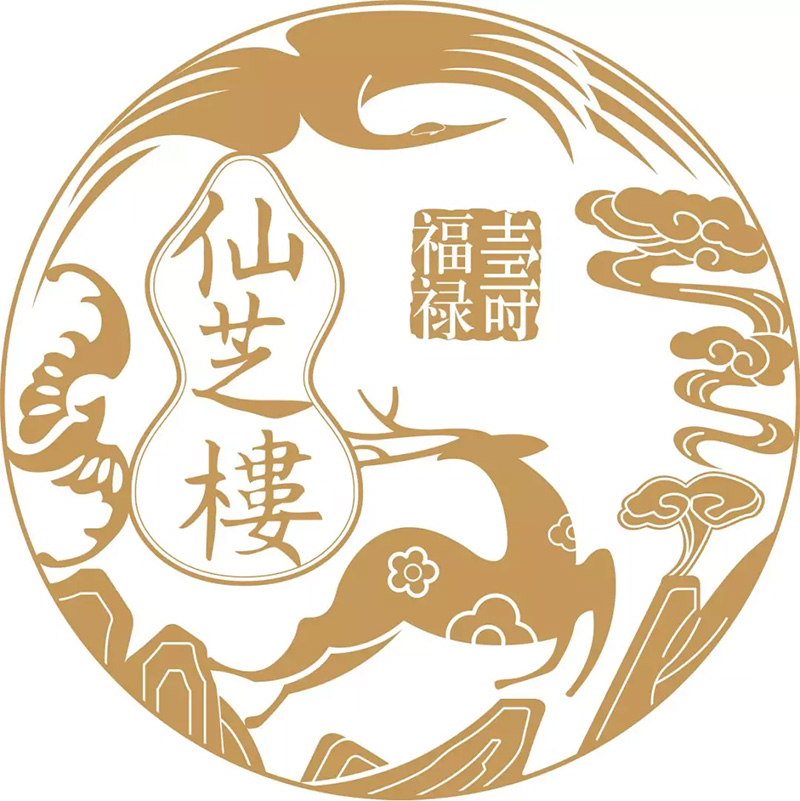
Pass on the Millennia Health Culture
Contribute to Wellness for All



